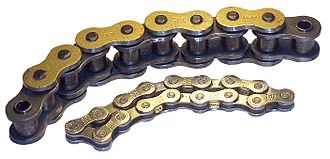There are two types of links alternating in the bush roller chain. The first type is internal links, having two inner plates held collectively by two sleeves or bushings upon which rotate two rollers. Inner links alternate with the second type, the external links, consisting of two external plates held with each other by pins moving through the bushings of the internal links. The “bushingless” roller chain is comparable in operation though not in construction; instead of separate bushings or sleeves keeping the inner plates jointly, the plate has a tube stamped into it protruding from the hole which serves the same purpose. This has the benefit of removing one part of assembly of the chain.
The roller chain design reduces friction compared to simpler designs, leading to higher efficiency and less wear. The original power transmission chain types lacked Conveyor Chain rollers and bushings, with both inner and outer plates kept by pins which straight contacted the sprocket tooth; nevertheless this configuration exhibited extremely rapid wear of both the sprocket the teeth, and 